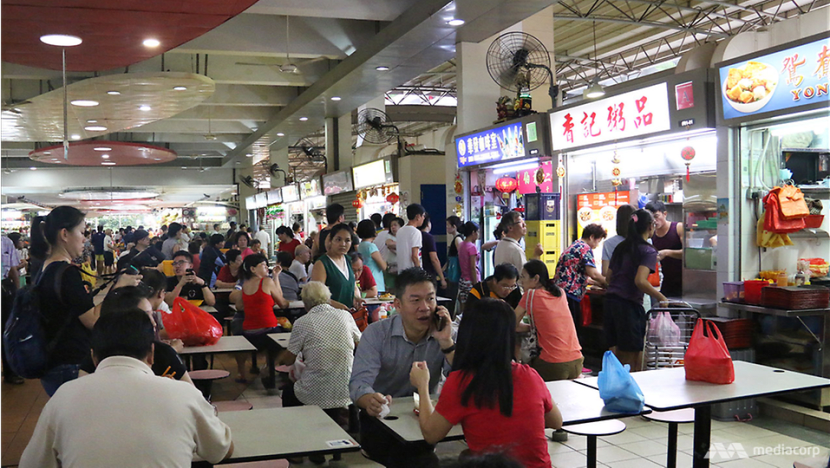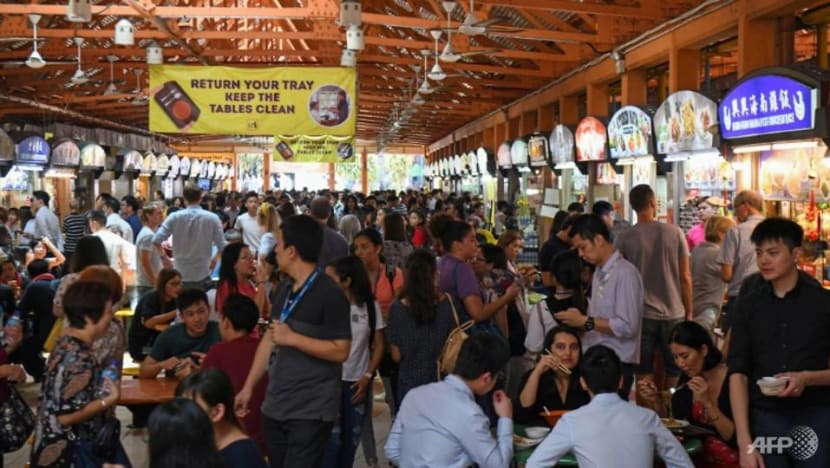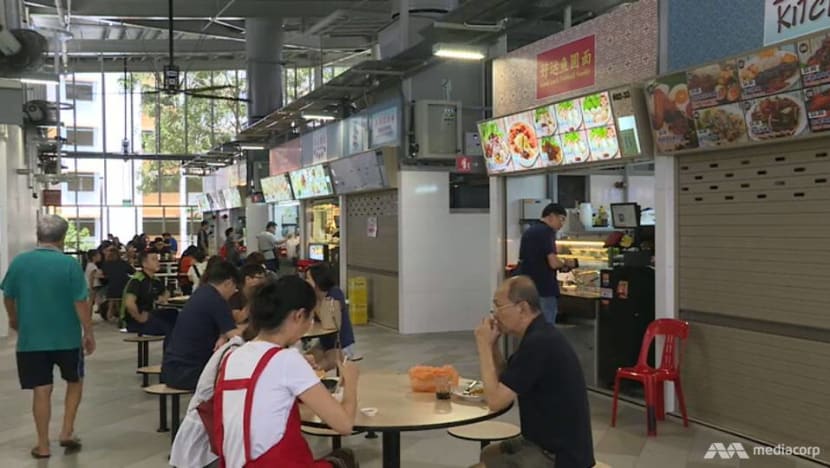commentary Commentary
Commentary: Protecting our hawker culture requires us to give hawkers more autonomy
While Singapore’s nomination for its hawker culture to be inscribed on the UNESCO Representative List is under consideration, our efforts to safeguard our hawker culture are worth a review, say two SUSS Business Law lecturers.

File photo of a hawker centre.
SINGAPORE: Chances are you stepped into a hawker centre over the last week for lunch, dinner or even enjoyed a sinfully good plate of nasi lemak for brunch.
And if you are going for a holiday in June, one of the first few things you might do after you return is to have a hearty meal at a hawker centre.
In March, Singapore officially submitted its nomination to inscribe Hawker Culture on the UNESCO Representative List of Intangible Culture Heritage of Humanity. If the nomination is accepted, it would promote greater international awareness of our hawker culture, recognise hawkers’ efforts and hopefully encourage future generations to continue the trade. It would be a symbolic win for Singapore hawkers.
READ: UNESCO listing may lift hawker culture but saving it is a different challenge, a commentary
However, efforts to safeguard the country’s hawker culture cannot rest simply on admissibility into the UNESCO Representative List.
Singapore’s hawker culture reflects our rich multicultural heritage. Hawker centres have also served an important function in Singapore society as accessible and affordable community dining spaces for many.
So much of our enjoyment of hawker food stems from the idea that we can partake in the creation of affordable, delicious food created by hawkers who have worked hard to arrive at their recipes and run a thriving business.
We must take a long, hard look at the lessons that we can draw from our recent experiment with the social enterprise hawker centre model, and continue to explore ideas that can place our hawker culture on a stronger footing for the future.
REVIEWING THE SOCIAL ENTERPRISE MODEL
When the Hawker Centres Public Consultation Panel, set up in November 2011, proposed the “social enterprise” management model for hawker centres, their objectives were to provide social benefits to the community, employment opportunities for lower-income and less privileged individuals, and help those who aspire to take up the hawker trade.
Socially-conscious enterprise hawker centres (SEHCs) were eventually introduced. Today, there are seven such hawker centres in Singapore managed by five socially conscious private enterprises.
However, over the years, the implementation on the ground by the SEHC operators led to some dissatisfaction in a number of areas.

While the operators did set out to improve the efficiencies of the hawker centre business through standardisation, centralisation and the introduction of innovative initiatives in driving increased footfall to the hawker centres and raising the standards of hawker fare, there were some complaints by a few stallholders about rising costs as well as onerous contractual requirements being placed on them.
Operators were accused of being too profit-minded and heavy-handed, which would seem inimical to the concept of the “socially-conscious enterprise”.
Last year, those issues were publicly debated after a petition signed by hawkers at Jurong West Hawker Centre, who apparently felt the pinch from paying hundreds of dollars per month for customers to return their trays, made headlines.
The National Environmental Agency (NEA) took action by reviewing the contractual terms between all five SEHC operators and their stallholders. This led to further discussions and subsequent changes to the contractual terms which took effect from Jan 1 this year.
The steps taken include the setting up of direct dialogue channels between stallholders and SEHC operators, and the extension of NEA’s “Productive Hawker Centres” grant – which help to partly fund the cost of a centralised dishwashing service.
These measures certainly make a difference in improving the operating environment for stallholders at the SEHCs. But deeper and more fundamental issues with the SEHC management model remain, suggesting that it’s worth reviewing our approach in this area.
READ: Can the real social enterprise hawker centre please stand up? A commentary
AN ALTERNATIVE CONTRACT
If we aspire to “walk the talk” in promoting the sustainability of our hawker culture as espoused in our UNESCO nomination, we may need to rethink the contractual paradigm which underpins the SEHC management model.
Some contracts signed by SEHC stallholders go beyond a typical corporate landlord and tenant relationship.

As previously reported in the media, some of these contracts carry somewhat intrusive terms including stipulations on the amount of calories in the dishes stallholders sell, and the “fines” payable for each day a stallholder closes if he or she does not give a week’s notice approved by the managing agent.
These non-essential terms could add to the hardship of stallholders. For example, a previous requirement to include healthier dining options by dictating the amount of calories in dishes restricts hawkers’ freedom in deciding what dishes to serve, while the requirement to provide a week’s notice for stall closure restricts the hawkers’ freedom to decide how they wish to operate.
Such terms should be taken out of the contract altogether, with business decisions left to stallholders if this is not already done.
The running of the business could then be left to the stallholders who will then be empowered to respond to market forces of demand and supply. If customers want healthier dining options, stallholders may be naturally incentivised to provide such options.
If customers want a premium version of a hawker dish with more expensive ingredients, stallholders may be keen to introduce such dishes and can choose to do so and raise prices accordingly, if consumers are willing to pay. But key here is the hawker’s autonomy.
READ: Healthier options ‘killing the hawker vibe’? Why so resistant, Singaporeans? A commentary
Hawkers should be free to adjust their food offering and pricing strategy based on market forces, and not be artificially restricted through contractual controls. This would also allow them to be more responsive to business conditions, and earn a fair income that keeps pace with inflation.
The alternative paradigm ought to be one where stallholders and operators are equal partners in the endeavour of creating a flourishing hawker culture. A hawker centre stands or falls by its hawkers. By empowering our hawkers, we also create the best conditions for the success of our hawker centres.
SEHC operators can then focus on the efficient running of hawker centres in a way that can best support hawkers.

ASSURING OUR HAWKERS AND FUTURE GENERATIONS
As authorities have maintained, the UNESCO nomination is not about staking ownership over hawker culture.
Instead, it demonstrates our collective will to protect this intangible heritage and the underlying social values that bind our society. It conveys our appreciation for past and present generations of hawkers and our commitment to support future generations who take up the trade.
Throughout this discussion and beyond, we should not fail to appreciate that a core focus in any future planning or decision-making should be the interests of hawkers and how they can be meaningfully supported and engaged, as their businesses ultimately concerns their livelihoods, passions and dreams.
This would also let the “socially-conscious enterprise hawker centre” model live up to the social aspirations of its moniker.
Regardless of the nomination outcome, all stakeholders – the Government, stallholders, centre management personnel, representative groups and the general public – should persist relentlessly with efforts to preserve hawker culture and what it stands for.
Cheng Kwang Hwee is a senior lecturer in the Singapore University of Social Sciences, with research interests in contract law and real estate business management. Tan Lee Cheng is a senior lecturer in the same university, with a research interest in Asian legal culture.
The views expressed are those of the authors and not necessarily those of the organisations with which they are affiliated or employed at.















